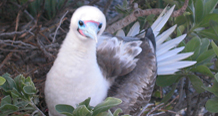Features

Brown Booby
This bird has a long body, long neck, and long tail with narrow, pointed wings.
Brown Booby

Great Frigatebird and Chick
With the largest wing area to body mass ratio of any bird, they are wonderfully adapted for an aerial lifestyle.

Red-footed Booby
This bird has a long, pointed, pale gray bill, a long pointed tail, long pointed wings, and bright red feet.
Red-footed Booby
Pacific Remote Islands Marine National Monument

Howland Island National Wildlife Refuge and six other national wildlife refuges are seemingly just dots near the equator of the Pacific Ocean, but upon a closer look these islands, reefs, and atolls are at the epicenter of Pacific Remote Islands Marine National Monument, one of the largest marine conservation areas in the world. These refuges host terrestrial and marine life in numbers and unique and specialized life forms beyond our imagination and they provide a safe haven for millions of birds and marine life that swarm to shallow areas and islands to rest, to feed, to mate, and to give life to their off-spring.
Learn MoreU.S. Fish and Wildlife Service
Howland Island National Wildlife Refuge is managed by the Fish & Wildlife Service in the Marine Monuments Program of the Pacific Islands Refuges and Monuments Office (PIRAMO). For more information contact: U.S. Fish and Wildlife Service/Howland Island National Wildlife Refuge, Box 50167, Honolulu, HI 96850 808-792-9540.
Monuments and Refuges of the Central Pacific OceanAbout the NWRS

The National Wildlife Refuge System, within the U.S. Fish and Wildlife Service, manages a national network of lands and waters set aside to conserve America’s fish, wildlife, and plants.
Learn more about the NWRS
Protecting the Pacific's Natural and Cultural Heritage
Colonizing the islands was a harrowing experience that claimed the lives of three young men: Carl Kahalewai who died of appendicitis in 1938, and Joseph Keliihananui and Richard “Dickey” Whaley who were killed during an attack on the island on December 8, 1941.
Learn more

Masked booby chick
The name "booby," originally coined by sailors, referred derogatorily to these birds' lack of fear around humans. Its feeding tactics are memorable: these dazzling white birds make high velocity plunge-dives in search of fish.
Page Photo Credits — USFWS
Last Updated: Mar 25, 2016